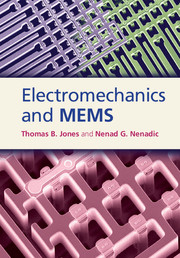Book contents
- Frontmatter
- Contents
- Preface
- 1 Introduction
- 2 Circuit-based modeling
- 3 Capacitive lumped parameter electromechanics
- 4 Small-signal capacitive electromechanical systems
- 5 Capacitive sensing and resonant drive circuits
- 6 Distributed 1-D and 2-D capacitive electromechanical structures
- 7 Practical MEMS devices
- 8 Electromechanics of piezoelectric elements
- 9 Electromechanics of magnetic MEMS devices
- Appendix A Review of quasistatic electromagnetics
- Appendix B Review of mechanical resonators
- Appendix C Micromachining
- Appendix D A brief review of solid mechanics
- Index
- References
1 - Introduction
Published online by Cambridge University Press: 05 May 2013
- Frontmatter
- Contents
- Preface
- 1 Introduction
- 2 Circuit-based modeling
- 3 Capacitive lumped parameter electromechanics
- 4 Small-signal capacitive electromechanical systems
- 5 Capacitive sensing and resonant drive circuits
- 6 Distributed 1-D and 2-D capacitive electromechanical structures
- 7 Practical MEMS devices
- 8 Electromechanics of piezoelectric elements
- 9 Electromechanics of magnetic MEMS devices
- Appendix A Review of quasistatic electromagnetics
- Appendix B Review of mechanical resonators
- Appendix C Micromachining
- Appendix D A brief review of solid mechanics
- Index
- References
Summary
Background
The trend toward device miniaturization and large-scale integration, which has already revolutionized electronics, now promises a profound transformation of engineered mechanical systems, reducing their size by orders of magnitude while vastly increasing their capabilities. Microelectromechanical systems (MEMS) are now found in automotive airbag systems, computer projectors, digital cameras, gyroscopic sensors, and many other devices. Their small size invites a high degree of on-chip integration with essential drive, detection, and signal conditioning circuitry. These collective advances have spawned another new term, the system-on-a-chip, with its own inevitable acronym, SOC. Consider as an example the digital camera. Nowadays, even rather inexpensive models have MEMS chips installed to sense the camera's orientation with respect to gravity and to detect and compensate for the inadvertent jolts and motions of the picture taker. Such features would have been well beyond the expectations of the owner of even the most expensive SLR camera of 20 years ago. The capabilities mentioned above are made possible by mechanical devices with dimensions less than a millimeter or so, fabricated on a chip side by side with all the required control and drive electronics.
Additional evidence for the vitality of this new technology is that the microfabrication industry has appropriated the term foundry to describe their facilities. This word dates from sixteenth-century French. One of the authors (TBJ) has a vivid childhood recollection from the 1950s of the nightly spectacle of fumes and fire belching impressively from the venting chimneys atop a metal casting foundry in the small Midwestern city where he grew up. This plant produced manhole covers and other essential yet mundane components of the urban infrastructure.
Information
- Type
- Chapter
- Information
- Electromechanics and MEMS , pp. 1 - 9Publisher: Cambridge University PressPrint publication year: 2013
